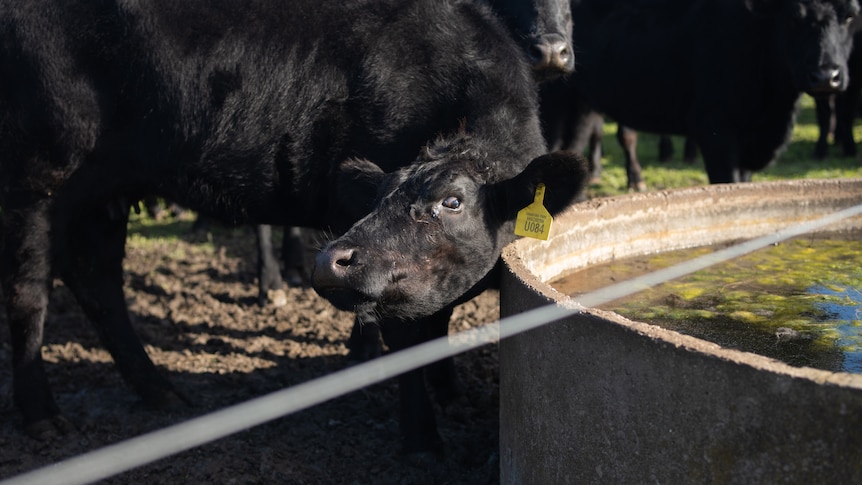Australia Weather News

Fodder has been in short supply in Tasmania due to unseasonably dry conditions in recent years. (ABC News: Mackenzie Heard)
In the far north-west corner of Tasmania, beef farmer Stafford Ives-Heres has just harvested a bumper crop of wine grapes from his hobby vineyard.
His hometown of Marrawah is beef and dairy country, relentlessly battered by the Roaring 40s, a powerful band of winds that circle the globe.
Traditionally, it is far too gusty and wet for fussy crops like grapes.
But despite welcome rain this weekend, the wider region has just experienced its lowest January to April rainfall levels since 1900, creating ideal wine grape growing conditions.
It is one small hint at a changing climate that could have serious consequences for Australia's food production.
Transitioning to a 'new normal'
The dry is likely a result of what climate researcher Tom Remenyi describes as a "post 2020" climate system, something scientists have been predicting for decades.
"All of the modelling kind of suggested that, at about 2020 the globe would move away from a historical climate into a new climate, and all of the evidence is suggesting that that is happening," Dr Remenyi says.
"We're kind of surprised it happened … [at] exactly the moment we were suggesting it would."
For Mr Ives-Heres, keeping an eye on the changing climate is crucial. He points out a couple of bulls in his paddock worth thousands of dollars, noting the loss of even one of them would be a financial gut punch.
Despite the record dry, his family farm fared relatively well over the summer.
It was a different story last year, when a more prolonged dry period left his family, along with thousands of other Tasmanians, scrabbling for hay, paying up to $250 a bale.
"We probably had five really good years on the trot … you can become a bit complacent as farmers," he says.
"But you do adapt to what is becoming the new normal. So, after what happened 12 months ago, we put in a feed budget or a feed plan to cut adequate fodder for the 2024-25 summer."
Help harder to come by
Down the road at Smithton, agricultural contractor Marcus Laing has a truckload of bales to deliver to local farms.
Many farmers he comes across cut enough hay and silage last through spring to carry them through the dry at the start of the year, but are hoping for a dump of rain before the cold sets in.
Over the years, Mr Laing has been involved in charity hay runs to other states, taking bales as far as drought-stricken Moree, about 630 kilometres north-west of Sydney.
This year, despite devastating floods and droughts across multiple states, that is not looking likely.
"They've had a hard run up there. They've probably lost crops and lost feed. But yeah, I don't think we're in a position really to help him this year," Mr Laing says.
"Every farmer should be cutting as much grass as they can. If there's spare feed, put it in the conserve feed."
Adaptation essential for survival
As sea and land temperatures rise, westerly rain-bearing fronts from the Southern Ocean that normally soak the state's western coast are being pushed further south between Tasmania and Antarctica, according to Dr Remenyi.
Meanwhile, easterly systems hitting the other side of the state are travelling down more frequently, but with long, dry spells in between.
Additionally, warmer temperatures drive evaporation rates up, meaning soil dries out faster than it used to.
"We end up having longer dry spells everywhere, and then higher intensity rainfall when it does rain.
"The dry days get drier, and the wet days get wetter," Dr Remenyi says.
He says while emissions reduction is important, reframing traditional farming practices will be crucial for Australia's food production.
"We need to recognise that we committed to this some decades ago, and this change is going to happen," he says.
"We will have to adapt. We need to make sure those farming systems are actually adapted to the climate they're going to experience moving forward."
For Mr Ives-Heres, who, along with his family, runs beef, a seaweed business and a small vineyard, as well as off-farm jobs, diversity is the key to survival.
Recently he started leasing a paddock in a different location, with hopes a different climate would provide a buffer against future weather events.
"We already take enough risks as it is in agriculture with Mother Nature, so having off-farm income or diversity within your business is paramount going forward if you're going to be seriously long-term about farming," he said.
"If we haven't got people producing food, we haven't got food. That's the black and white of our scenario."
If you have a general news tip or feedback, please contact us via this formABC